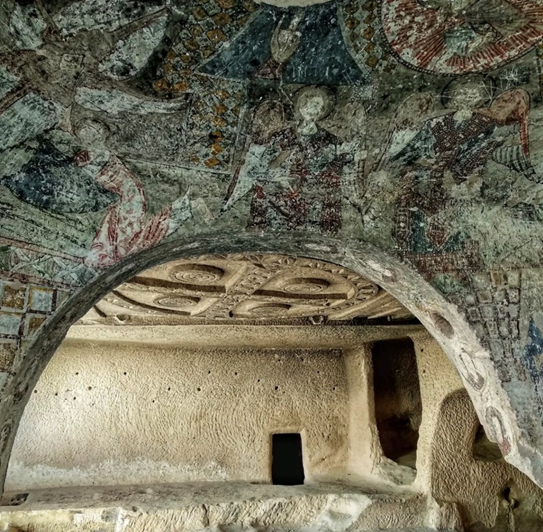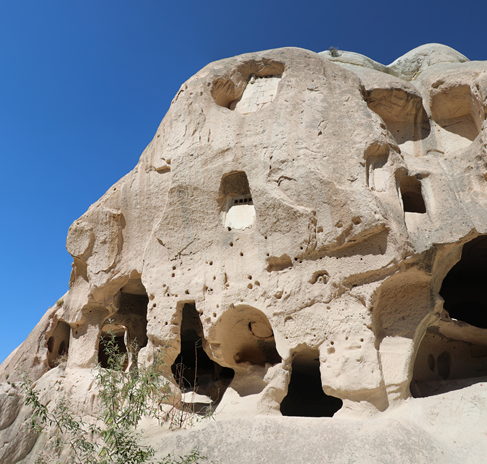General Information
At the beginning of Güllüdere Valley, on the stream bed road, the Three Cross Church (No. 3) is located” (Şen Ekici and Diğ, 2022: 921). The church is reached by passing through vineyards and apricot trees. The church took its name from the three cross motifs carved on its ceiling. “The church, which has no protective measures, has a steep entrance” (Şen, 2019: 59; Türker, 2008: 28).
“Most architectural forms are continuations of earlier periods and do not contain features that would assist in dating. As a result, chronology is often determined based on illustrated decorations or inscriptions. However, this approach is also problematic, as many buildings from the early periods appear to have been re-painted at later dates. The same applies to the Three Cross Church No. 3 in Güllü Dere” (Ousterhout, 2019: 106; In Lemaigre Demesnil, N. “L'architecture Religieuse Ruprestre En Cappadoce Jusqu'a Milieu Du IX' Siecle.” Ph.D. Thesis, University of Faris l, 2000).
“During the condensation of moisture on the mural, the wetting of the rock with rainwater or ground water, or the diffusion of gaseous water vapor through the wall into the atmosphere; Deterioration occurs in pigments and plaster due to the solvent effect of water. During construction, the surface area was increased by notching the plaster with tools so that it could adhere to the surface. The mobility of moisture causes the salts to be carried along with it, crystallizing from the plasters based on the rock structure and causing salt outflow. As a result of losing its binding (adhesive) quality, the paint layer and the thin layer of plaster applied as a single layer on the rock surface cause lacunae to form and fall off by foliation (Şen, 2019: 154). ).
“Although the Three Cross Church is statically more protected than other churches, it has small-scale structural cracks” (Şen, 2019: 154).
Plan and Building Description: Located at the beginning of Güllüdere Valley, the Three Cross Church has a rectangular plan in north-south direction. The church has a flat-ceilinged nave and an apse towards the north. There is a large opening on the east side of the nave and two vertical entrances on the north side. On the ceiling of the church, the cross medallion in the center and the palm tree reliefs on both sides are noteworthy. There are two chambers in the west direction; It is thought that these rooms were used as storage, and the channels on the apse walls were used to irrigate the gardens. The church took its name from the three carved cross motifs on its ceiling. The construction phases of the church are divided into two periods. The south church and narthex were completed in the first period, and the burial chamber and north church were completed in the second period. The building dates back to the end of the 9th and the beginning of the 10th centuries (Jolivet-Levy, 1991: 35). The Three Cross Church is also referred to as Güllüdere Chapel No. 3 and St. Agentangeus Church in various sources (Toper, 2019: 43).
Exterior Features: Three Cross Church has a steep entrance and is a structure carved into the rock (Photo 1). While the western door opens to the burial chamber, there are two short graves on the floor of the chamber. It is estimated that the rooms located near the entrance served as storage. The ceiling decorations are inspired by patterned wooden cassette ceilings and represent the unique rock-carved architecture of Cappadocia (Ousterhout, 2019: 88).
Interior Description: The nave of the church is quite wide compared to its length. The apse contains characteristic elements dating back to the 10th century. The relief crosses and palm motifs among the ceiling decorations add a unique aesthetic to the church. The apse and most of the walls of the south nave have been destroyed. However, the flat ceiling of the narthex and the arched cross motif have survived to the present day. The north nave is completed with a barrel-vaulted ceiling and apse. In this section, there is a small rectangular niche in the eastern background. Three large blind arcades carved between the walls reflect the architectural richness of the place.
“There is a Latin Cross in the middle of the ceiling, cross reliefs in medallions on both sides, and two palm reliefs next to them” (Şen Ekici and Diğ, 2022: 924). “The nave of the Three Cross Church in Güllü Dere is also much wider compared to its length. In the tenth century, many churches around Göreme were carved to have transverse naves” (Ousterhout, 2019: 223). “There are two very steep entrances, from the apse on the north side of the church and from the large opening on the east side of the naos. There are two chambers on the west side of the naos and a large niche in the apse. "It shows that the chambers were used for storage and the channels opened in the apse walls were used to irrigate the gardens surrounding the church" (Şen, 2019: 71).
“Güllüdere Church No. 3 (Three Cross Church), which has a central cross medallion and an arched Latin cross with palm trees next to it, is noteworthy (Photo 2).
Although relief crosses continued to be used in wall and ceiling decorations as late as the tenth century, similar decorations can be found in masonry churches that have survived to the present day. Certain elements of decoration, such as cascades and embossed moldings, can also be seen in sixth-century masonry architecture, but the elaborate ceiling decorations appear to represent an independent development in response to the unique rock-cut environment of Cappadocia. These may have been inspired by patterned wooden cassette ceilings” (Ousterhout, 2019: 88).
Exterior Depiction: Deteriorations caused by rainwater and moisture can be seen in the exterior of the church. The movement of moisture caused the layers of plaster and paint to break off and flake off. Although it is statically well preserved, there are small-scale structural cracks.
Decoration Program: The decorations of the Three Cross Church consist of elements specific to the iconoclastic period and frescoes that can be dated to the Middle Ages (Şen Ekici and Diğ, 2022: 933). There is a Latin Cross in the middle of the ceiling, with cross reliefs and palm reliefs in medallions on both sides. The apse and walls are covered with frescoes containing scenes important to Christianity.
The church contains red line decorations from the early period and frescoes from the later periods. These frescoes include the Maiestas Domini scene and portraits of saints. However, due to natural reasons, color loss in the frescoes and flaking of the plaster layer are observed.
© 2025 Digital Cappadocia. All rights reserved. Unauthorized use of this content is prohibited.
How to get there?
2. Küme, 50502 Çavuşin/Avanos/Nevşehir




